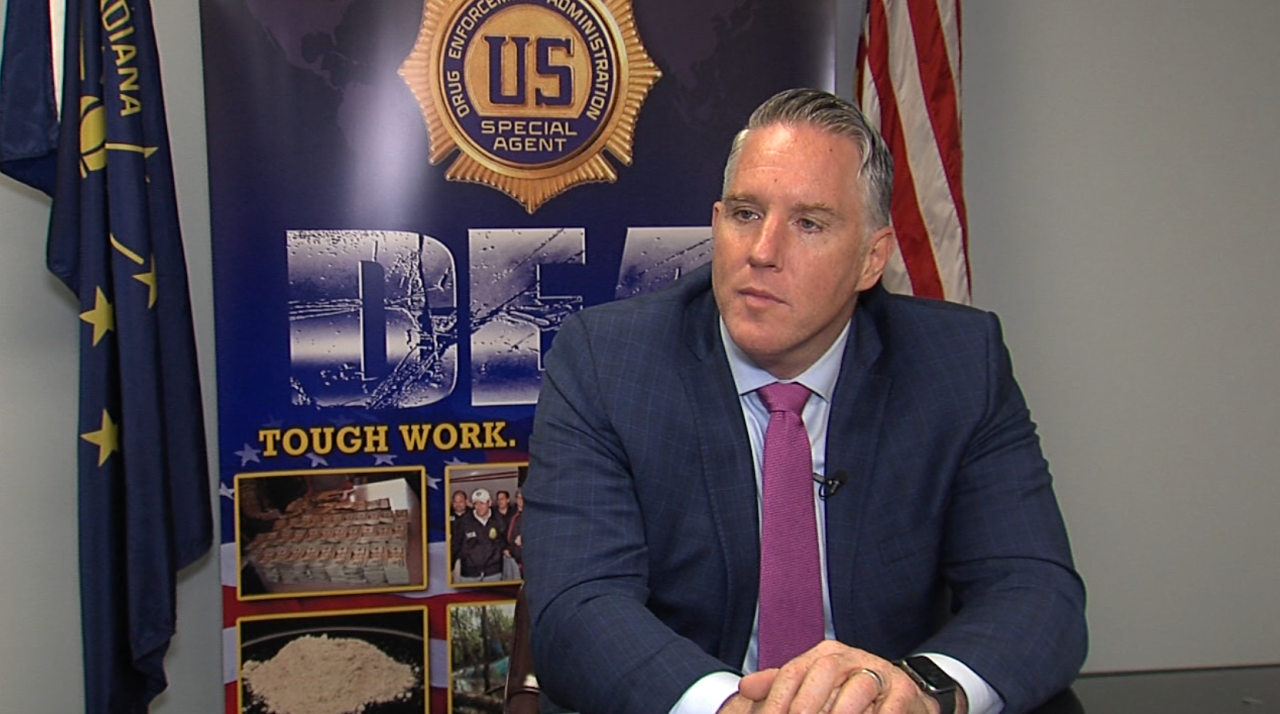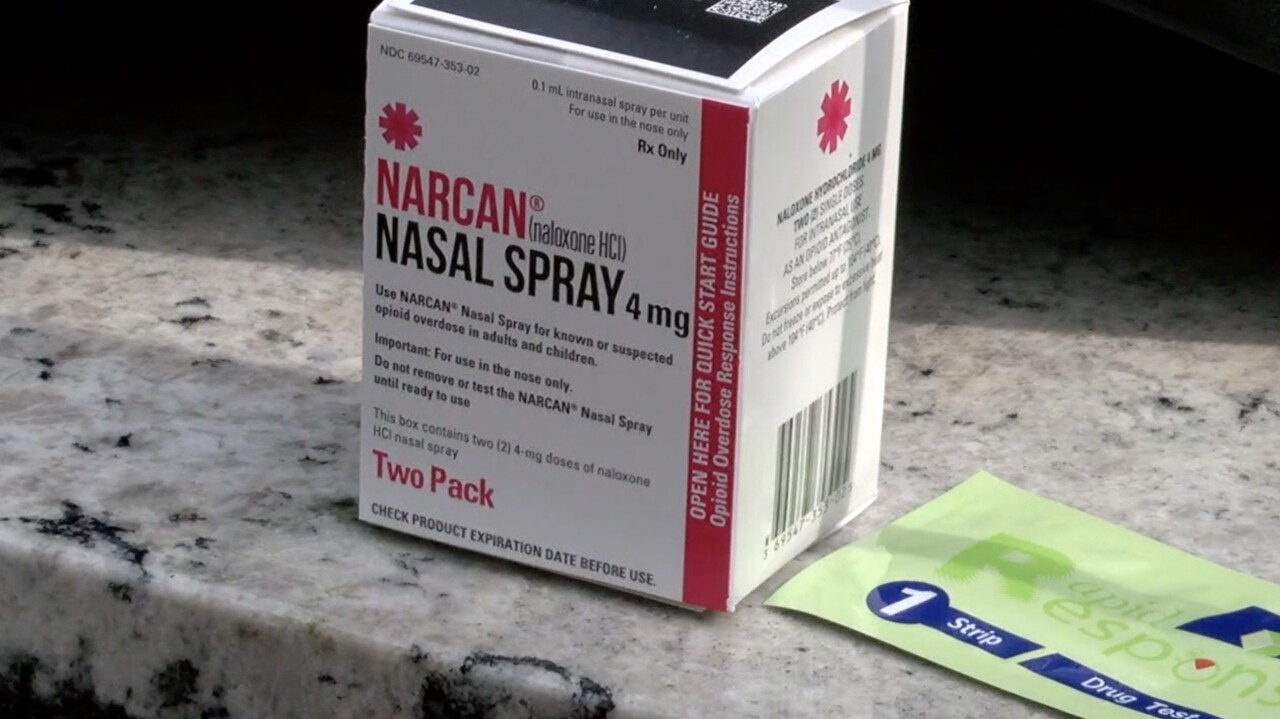INDIANAPOLIS — On International Overdose Awareness Day, a day to raise awareness about the opioid crisis and remember those who died of an overdose, officials are concerned about the increase in fatal overdoses in Indiana.
In 2021, more than 107,000 Americans died from drug overdoses. Indiana had 50% more overdoses than in previous years, but not all of those resulted in death.
The problem hasn't gotten any better.
So far this year, more than 500 people have died from overdoses in Marion County alone.
The coroner's office says nearly 80% of those deaths were from fentanyl.
"We've seen the most deaths that we've seen in probably 10 years or more," Marion County Deputy Coroner, Alfarena McGinty said.
The opioid crisis continues to claim the lives of Hoosiers.

"It's so sad to say that it's nearly every day, and sometimes three to four times a day that we are investigating a drug overdose death," she said.
McGinty says Indianapolis is on track to shatter 2021's record number of overdoses.
Her office has investigated 500 overdose deaths so far this year and nearly 70 more cases are still pending toxicology results.
"It's very scary," McGinty said.
She said fentanyl, which is a powerful synthetic opioid, that the CDC lists as 50 to 100 times more powerful than morphine is the driving force behind these deaths.
"The majority, the majority again, you know, fentanyl is mixed in everything, any pills that we see any powdery substance that we see on death investigation scenes. Fentanyl is by and large one of the ingredients that is in those substances that are ingested," McGinty said.
What's even scarier for McGinty is she's never seen as many different strands of fentanyl being found on our streets and toxicology reports.
"This is the first time ever, that we've seen so many involving so many different types of analogues of fentanyl as well," McGinty said. "So, it's not just one type of fentanyl or just fentanyl. There's probably 10 different analogues that we are seeing, and they impact people differently when they ingest them. So, it's a critical issue that we can't really wrap our hands around how we deal with it."
A small amount can kill.
"Just two milligrams of fentanyl can be considered a lethal dosage unit just sent enough to maybe tip fit on the tip of a pencil," DEA Special Agent in Charge Michael Gannon said.

Gannon said fentanyl is made in China, shipped to Mexico and then brought across the border.
"Then, the cartels take full advantage of that and then they'll put that in all types of drugs. They flood the United States with the fentanyl whether it's in a powdered form, or in various pills," Gannon said.
Hundreds of thousands of pills and kilos of the deadly drug have come through the Crossroads of America.
Fentanyl is used in hospitals but now, Gannon said, drug dealers are illegally experimenting in labs with higher and lower doses of fentanyl, lacing heroin, cocaine, meth, pain pills such as Xanax, Adderall and more.
The pills often look identical to prescription medication.
"Oh you could put them right next to each other and you can't always determine the difference," Gannon said.
The drugs get passed from dealer to dealer.
Many don't even know fentanyl is present until an overdose.
"At the end of the day, they don't care about someone. They care about making money and the easy way and if someone were to get harmed because of it, they look at it like 'Oh well,' and that is the important message that gets across." Gannon said. "How many times is a family member going to be crushed and devastated because they lost a loved one to fentanyl poisoning."

"It's very devastating. I just don't understand where there is no human compassion, how anybody can put this drug out there knowing it's killing people. I guess overall the money is more important than lives," Brenda Trent said.
Trent knows the pain this crisis is causing families.
"He was my baby," Trent said.
She lost her son, Karl Carnes, in June to an overdose.
"It was a pretty bad scene. He had been in the car for two days," she said. "It's a struggle. It's a sudden loss and I think we are all doing the best we can but then we realize the holidays are coming up and we are wondering how we are going to get through it."
The 30-year-old was a father, son, brother and husband-to-be.
"He was a loving son. He loved his mama. and he didn't wanna hurt me but I understood. It really hurts," Trent said.
Trent said Carnes battled addiction for 15 years.
"He went from Vicodin to stronger Oxycontin. Then when the FDA or whoever pulled the doctors from prescribing that stuff it became heroin, but he was more than an addict. He was my son and he wanted to be clean so bad and he struggled so hard to become clean," Trent said.
The Carnes family isn't alone.

Marion, Lake and Allen counties have the highest opioid death rates in Indiana, but every county is suffering.
"We just are trying to keep up we're spinning our wheels, toxicology labs, coroner's offices, medical examiner offices are essentially spinning our wheels, trying to keep up," McGinty said.
McGinty said death investigations are at an all-time high.
To keep up with the cost and high demand of death investigations, the Indiana Department of Health is pouring $1.5 million into county coroner's offices across the state.
"We're looking at roughly close to $3,000 per investigation, when you're talking about all the time that goes into these types of investigations," McGinty said.
The Indiana Department of Health has been awarded two grants to address drug overdose prevention and surveillance: the Centers for Disease Control and Prevention 2023 overdose data to action for $6,953,983 and the substance abuse and mental health services administration – 2023 first responders comprehensive addiction and recovery act for $800,000.

"There is no better than to spend these dollars to prevent the next crisis that is coming," Executive Director of Drug Prevention and Enforcement for the state, Douglas Huntsinger, said.
Millions are being spent on naloxone, also known as Narcan.
It's a life-saving opioid overdose treatment that's accessible in all of Indiana's 92 counties.

More than 2,075 doses have already been given by Indianapolis Emergency Medical Services this year.
"As a service, we are using it daily and we are definitely using it more. We go on multiple overdoses a day here in the city," Ryan Roseneau said.
Roseneau said paramedics are seeing a rash in stronger drugs laced with fentanyl leading to an uptick in overdose calls.

The drugs are so potent, up to four doses of Narcan are being used to bring the patient back to life.
"Our protocol calls for 2-milligram nasal dose initially, but we are seeing four and 8 milligrams before we are seeing a response. Whereas even a year ago sometimes, we were getting a response with one dose," Roseneau said.
Investigators said although resources are in place, the grim reality is fentanyl isn't going away anytime soon.
"Oh, it's a big issue. There's no question about it," Gannon said.
"It's just an overall burden that we're trying to wrap our brains around," McGinty said.
"It just doesn't affect the addict, kids are losing their parents, grandparents are raising their grandchildren more needs to be done," Trent said.
How are agencies working together to crack down on these drug dealers?
They're tracking the compounds of fentanyl found in toxicology reports and keeping a close eye on trends.
For example, earlier this year nearly 50 people died in one weekend from overdoses, which sparked an investigation into if the bad batches were from the same dealer.
MORE | Advocate issues overdose warning after Marion County sees increase over weekend
Parents need to be on the lookout for potentially deadly fentanyl made to look like candy that's appealing to children.
The DEA said the brightly colored pills have been "rainbow fentanyl." The DEA said this appears to be a new method by drug cartels to sell this highly addictive and potentially deadly drug to kids and young people.
The DEA says it's been found in 18 states, including Indiana.
"Over the last several years were seized and hundreds of 1,000's of pills and it's here. We've even see some of the rainbow colored pills, that were there making the fake pills with fentanyl that are obviously different colors, rainbow color. So it's definitely here, and people need to be aware of and we've been, we've been talking about this for years. We've even seized kilogram quantities of fentanyl that have had Chinese imprints on it," Gannon said.
Resources
If you or someone you know is dealing with a substance use-related emergency, call 911.
For more information on a recovery organization near you, you can visit the Indiana Recovery Network website.
You can call 211 for help 24/7 in Indiana.
You can call the Indiana Addiction Hotline at 1-800-622-HELP (4357).
To find where you can get Naloxone near you, click here.
To learn more about NaloxBoxes, click here. You can use this map to find one near you.
To view more resources from NextLevel Recovery Indiana, click here to visit its website.
Learn More
Click here to learn more about substance use disorders.
Substance use disorder-related data from the state.
-

Future of I-65, I-70: INDOT concludes ProPEL Indy study
I-65 and I-70 are two of the main ways to get in and around the Indy metro. The city's transportation network is due for a major revamp in the coming years.
IMPD specialized teams recover nearly 2,000 guns in 2025
Newly released numbers from the Indianapolis Metropolitan Police Department highlight the significant impact of specialized teams working to reduce violent crime across the Circle City.
Carmel Police roll out new tech to protect officers during traffic stops
The Carmel police are introducing new technology to protect officers during traffic stops, following a weekend when three Indiana State Police vehicles were struck while parked on the roadside.
Holiday prices rise as tariffs and inflation hit retailers and customers
The most wonderful time of the year could soon become the most expensive as retailers and customers alike deal with rising inflation, new tariffs and higher operating costs this year.






